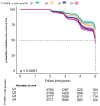The Association Between the Triglyceride-to-High-Density Lipoprotein Cholesterol Ratio and the Risk of Progression to Diabetes From Prediabetes: A 5-year Cohort Study in Chinese Adults
- PMID: 35923622
- PMCID: PMC9340202
- DOI: 10.3389/fendo.2022.947157
The Association Between the Triglyceride-to-High-Density Lipoprotein Cholesterol Ratio and the Risk of Progression to Diabetes From Prediabetes: A 5-year Cohort Study in Chinese Adults
Abstract
Objective: Evidence regarding the relationship between the triglyceride-to-high-density lipoprotein cholesterol (TG/HDL-c) ratio and the risk of progression from prediabetes to diabetes remains limited. The purpose of our study was to investigate the relationship between the TG/HDL-C ratio and incident diabetes in prediabetic patients.
Methods: This retrospective cohort study covered 32 regions and 11 cities in China and consecutively and non-selectively collected data from 15,017 patients with prediabetes who had received a health check from 2010 to 2016. Data were obtained from the DATADRYAD database (www.datadryad.org). The Cox proportional-hazards regression model with cubic spline functions and smooth curve fitting (cubic spline smoothing) was used to explore the non-linear relationship between the baseline TG/HDL-c ratio and the risk of diabetes in patients with prediabetes. In addition, we performed a series of sensitivity and subgroup analyses.
Results: The mean age of the included individuals was 50.95 ± 13.48 years, and 9,745 (64.51%) were men. The median (interquartile range) TG/HDL-c ratio was 1.09 (0.69-1.72). During a median follow-up time of 3.05 years, 1,731 (11.46%) patients had a final diagnosis of diabetes. The analysis after adjusting for covariates showed that the TG/HDL-c ratio was positively related to incident diabetes in patients with prediabetes (HR = 1.111, 95% CI 1.061-1.164). Participants with the highest TG/HDL-c ratio (Q4) had higher diabetes incidence rates than those with the lowest TG/HDL-c ratio (Q1) (P < 0.001 for the trend). There was a non-linear relationship between the TG/HDL-c ratio and the risk of diabetes, and the inflection point of the TG/HDL-c ratio was 1.415. The effect sizes (HR) on the left and right sides of the inflection point were 1.336 (95% CI: 1.134-1.573) and 1.055 (95% CI: 0.988-1.126), respectively. The sensitivity analysis demonstrated the robustness of these results.
Conclusion: This study demonstrates a positive, non-linear relationship between the TG/HDL-c ratio and the risk of diabetes in Chinese patients with prediabetes. Aggressive intervention from a treatment perspective is required to lower the TG/HDL-c ratio below the inflection point (1.415) by lowering TG or increasing HDL-c levels.
Keywords: diabetes; dyslipidemia; nonlinear; prediabetes; smooth curve fitting.
Copyright © 2022 Sun, Wang, Huang, Hu and Han.
Conflict of interest statement
The authors declare that the research was conducted in the absence of any commercial or financial relationships that could be construed as a potential conflict of interest.
Figures






Similar articles
-
Risk factors for progression to type 2 diabetes in prediabetes: a systematic review and meta-analysis.BMC Public Health. 2025 Mar 31;25(1):1220. doi: 10.1186/s12889-025-21404-4. BMC Public Health. 2025. PMID: 40165126 Free PMC article.
-
Triglyceride to high-density lipoprotein cholesterol ratio is associated with regression to normoglycemia from prediabetes in adults: a 5-year cohort study in China.J Transl Med. 2023 Nov 30;21(1):868. doi: 10.1186/s12967-023-04752-w. J Transl Med. 2023. PMID: 38037094 Free PMC article.
-
Association of Triglyceride to high-density lipoprotein cholesterol ratio and incident of diabetes mellitus: a secondary retrospective analysis based on a Chinese cohort study.Lipids Health Dis. 2020 Mar 4;19(1):33. doi: 10.1186/s12944-020-01213-x. Lipids Health Dis. 2020. PMID: 32131838 Free PMC article.
-
Association between triglyceride-to-high-density lipoprotein cholesterol ratio and prediabetes: a cross-sectional study in Chinese non-obese people with a normal range of low-density lipoprotein cholesterol.J Transl Med. 2022 Oct 22;20(1):484. doi: 10.1186/s12967-022-03684-1. J Transl Med. 2022. PMID: 36273126 Free PMC article.
-
Association between triglyceride to HDL cholesterol ratio and a risk of diabetes mellitus: a systematic review and meta-analysis.Lab Med. 2025 Jan 6;56(1):1-6. doi: 10.1093/labmed/lmae052. Lab Med. 2025. PMID: 39066659
Cited by
-
Association between the triglyceride to high-density lipoprotein cholesterol ratio and diabetes mellitus likelihood in patients with chronic kidney disease.BMC Nephrol. 2025 Aug 19;26(1):470. doi: 10.1186/s12882-025-04377-9. BMC Nephrol. 2025. PMID: 40830768 Free PMC article.
-
Elevated body fat percentage is linked to increased risk of diabetes: a longitudinal retrospective cohort study based on Chinese adults.Front Nutr. 2025 Jun 19;12:1510210. doi: 10.3389/fnut.2025.1510210. eCollection 2025. Front Nutr. 2025. PMID: 40612313 Free PMC article.
-
Risk factors for progression to type 2 diabetes in prediabetes: a systematic review and meta-analysis.BMC Public Health. 2025 Mar 31;25(1):1220. doi: 10.1186/s12889-025-21404-4. BMC Public Health. 2025. PMID: 40165126 Free PMC article.
-
Triglyceride to high-density lipoprotein cholesterol ratio is associated with regression to normoglycemia from prediabetes in adults: a 5-year cohort study in China.J Transl Med. 2023 Nov 30;21(1):868. doi: 10.1186/s12967-023-04752-w. J Transl Med. 2023. PMID: 38037094 Free PMC article.
-
Global research trends in prediabetes over the past decade: Bibliometric and visualized analysis.Medicine (Baltimore). 2024 Jan 19;103(3):e36857. doi: 10.1097/MD.0000000000036857. Medicine (Baltimore). 2024. PMID: 38241546 Free PMC article.
References
-
- Peters SA, Huxley RR, Woodward M. Diabetes as Risk Factor for Incident Coronary Heart Disease in Women Compared With Men: A Systematic Review and Meta-Analysis of 64 Cohorts Including 858,507 Individuals and 28,203 Coronary Events. Diabetologia (2014) 57(8):1542–51. doi: 10.1007/s00125-014-3260-6 - DOI - PubMed
MeSH terms
Substances
Associated data
LinkOut - more resources
Full Text Sources
Medical
Miscellaneous

